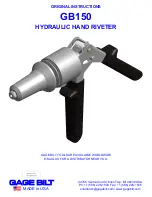
13.
Use personal protective equipment. Always wear eye protection.
Protective equipment such as dust
mask, non-skid safety shoes, hard hat or hearing protection used for appropriate conditions will reduce
personal injuries.
14.
Prevent unintentional starting. Ensure the switch is in the off-position before connecting to power
source and/or battery pack, picking up or carrying the tool.
Carrying power tools with your finger on the
switch or energizing power tools that have the switch on promotes accidents.
15.
Remove any adjusting key or wrench before turning the power tool on.
A wrench or a key left attached to
a rotating part of the power tool may result in personal injury.
16.
Do not overreach. Keep proper footing and balance at all times.
This enables better control of the power
tool in unexpected situations.
17.
Dress properly. Do not wear loose clothing or jewelry. Keep your hair and clothing away from moving
parts.
Loose clothes, jewelry or long hair can be caught in moving parts.
18.
If devices are provided for dust extraction and collection, ensure these are connected and properly
used.
Use of dust collection can reduce dust-related hazards.
19.
Do not let familiarity gained from frequent use of tools allow you to become complacent and ignore tool
safety principles.
A careless action can cause severe injury within a fraction of a second.
POWER TOOL USE AND CARE
20.
Do not force the power tool. Use the correct power tool for your application.
The correct power tool will
provide better safer results when used according to its specifications.
21.
Do not use the power tool if the power switch does not turn it on and off.
Any power tool that cannot be
controlled with the switch is dangerous and must be repaired.
22.
Disconnect the plug from the power source and/or remove the BATTERY pack, if detachable, from the
power tool before making any adjustments, changing accessories, or storing power tools.
Such preventive safety measures reduce the risk of starting the power tool accidentally.
23.
Store idle power tools out of the reach of children and do not allow persons unfamiliar with the power
tool or these instructions to operate the power tool.
Power tools are dangerous in the hands of untrained
users.
24.
Maintain power tools and accessories. Check for misalignment or binding of moving parts, breakage of
parts and any other condition that may affect the power tool’s operation. If damaged, have the power
tool repaired before use.
Many accidents are caused by poorly maintained power tools.
25.
Keep cutting tools sharp and clean.
Properly maintained cutting tools with sharp cutting edges are less
likely to bind and are easier to control.
26.
Use the power tool, accessories and tool bits etc. in accordance with these instructions, taking into
account the working conditions and the work to be performed.
Use of the power tool for operations
different from its intended purpose could result in a hazardous situation.
27.
Keep handles and grasping surfaces dry, clean and free from oil and grease.
Slippery handles and
grasping surfaces do not allow for safe handling and control of the tool in unexpected situations.
SERVICE
28.
Have your power tool serviced by a qualified repair person using only identical replacement parts.
This will ensure that the safety of the power tool is maintained.
29.
Users or full-service dealers need to be aware that a spring is housed inside the feed system.
It will release from its constrained position during disassembly.
Normal precautions should apply.
GENERAL POWER TOOL SAFETY WARNINGS
5






































